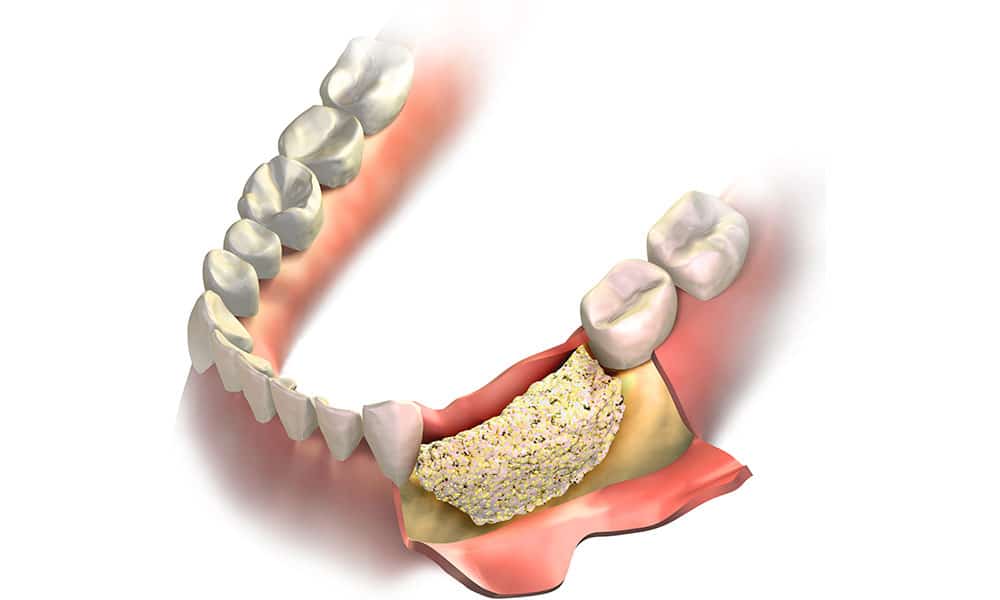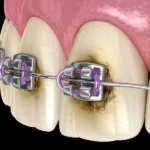What Are The Benefits Of Dental Bone Grafting?

The idea of dental bone grafting and bone augmentation has been around for some time. The procedure is considered minimally invasive and can usually be completed in an outpatient capacity. A bone graft is required when there is insufficient jawbone mass to hold a dental implant securely in place. Everything from missing teeth to gum disease and some other systemic diseases can result in a loss of bone.
Bone augmentation for dental implants requires a suitable material that is often taken from several different sources. Bone material can be taken directly from various locations throughout the body, such as the hip or lower jaw. Bone can also be sourced from animals. Various types of synthetic bone materials are produced in the laboratory. Today,Bone grafting is considered a standard and routine procedure that is not only done for dental patients but also for cosmetic surgery. Bone grafting sometimes is used to mechanically prevent surrounding tissue from collapsing while integration and healing are allowed to occur. This kind of process is referred to as guided tissue regeneration. Over time, the graft is absorbed by the body and replaced with the patient’s native bone material.
Table of Contents
Do I need Bone Graft After Tooth Removal?
There are cases where an implant can be placed at the time of tooth extraction, this is usually not the case. After tooth removal a preservation graft is used to fill the void. The procedure helps to efficiently fill the void within the space resulting from tooth extraction while the natural bone is given time to grow and fill the space. In most situations, this kind of bone augmentation requires three to six months of stabilization before a dental implant can be placed. The grafting material most commonly used for a ridge preservation graph contains natural bone mineral content. With this type of procedure, the graft material is immediately placed into the empty hole resulting from a tooth extraction. Over time integration and healing will occur naturally.
Understanding Dental Bone Grafting
In the most basic of terms, bone grafting is simply a process that is used to replace missing bone mass to remedy bone loss or bone fractures. Not surprisingly, it can be done in virtually all parts of the body and is not limited to only dental treatment. In short, when a patient loses one or more teeth through injury, trauma, or gum disease graft may be used. It enables a patient to maintain their current bone shape or form. This is important in that it prevents further bone degradation over time.
Most impressive of all is the fact that bone grafts can be used in a very beneficial way to help patients who have had teeth pulled many years prior. The procedure is intended to restore the bone to its previous density and shape. Here are a few key benefits that can be enjoyed by patients who choose to have these procedures as part of their dental care treatment.
Health Benefits of Dental Bone Grafting
Many patients often ask the question of why it is important to maintain jawbones in their original form. One of the most important answers to this question is that the restoration of bone mass and structure helps patients to avoid developing other types of dental problems or diseases. From a structural standpoint, bone grafting is instrumental in a wide variety of facial bone and facial structure restoration and maintenance related treatments. Helping patients enjoy higher levels of personal self-esteem and self-confidence in addition to restoring functionality are all excellent reasons why dental bone graft procedures are routinely used in contemporary dentistry
Perhaps one of the most important and most common scenarios where these procedures are used is when tooth loss has occurred. In short, when teeth go missing, the result can be that the alveolar bones or the bones that are primarily intended to hold teeth in place can eventually atrophy or mostly waste away.
In most cases, the atrophy of alveolar bones will occur within the first three years of losing teeth either through injury, disease, or normal extraction. When a void is left in the area where a tooth once existed, the surrounding bone will eventually atrophy and even be reabsorbed into the body. This may ultimately cause deformity, preventing standard functionality such as being able to speak, eat, or do other routine activities.
In more extreme cases, the deformity may occur, which can result in the patient experiencing various levels of pain and even muscular dysfunction. Perhaps most alarming and indeed concerning of all is that if the patient waits too long before correcting the problem, there may be insufficient soft tissue or bone needed to support dental implants or other types of prosthetic replacements. Grafting of bone is a highly respected and trusted medical procedure that is intended to improve the appearance and provide a more stable platform for dental implants and other dental appliances. Grafting work is also essential to ensure the proper placement of crowns and dentures whenever necessary. All of these procedures require a secure and robust jawbone that is then used as a stable and reliable anchor.
Patients who require bridgework often receive bone grafts in the anterior region as a way to preserve ridge topography. This is a beneficial procedure that ultimately improves the functionality and appearance of bridgework, dentures, or other types of dental appliances. It should be noted that the resulting space caused by missing teeth often results in other surrounding remaining teeth moving or shifting. The concern with shifting or moving teeth is that there may eventually be changes in overall facial bone structure. The grafting of bone is an effective way of preventing this from occurring.
There are other situations where grafts are required. This includes when a patient has some sinus deficiency or tumor. Grafts are equally useful when there has been a bacterial infection of the patient’s jawbone, or there has been some trauma, injury, or misalignment that has occurred. In short, the grafting of bone is a versatile, highly efficient, and useful way of dealing with a broad range of dental care-related problems and issues that are often seen today.
How Much Is Bone Grafting Needed?
The severity or degree of bone loss will typically determine the amount or degree of grafting required. In most situations, your dental care provider or oral surgeon will determine the exact amount of bone needed for your particular and unique case. For most procedures, the grafting material is sourced from synthetic sources, the patient’s bone, or a tissue bank.
The dental bone grafting, while very exacting and delicate, is routine and makes use of the latest advanced technology and modern dental procedures. With incredibly high success rates, dental bone grafting is a smart and sensible way of improving dental health while helping patients to maintain a more attractive outward appearance. Talk with your dental care provider to determine whether or not dental bone grafting is right for your individual dental care needs.
How Can I Get Dental Implant If I Don’t Have Enough Bone?
Implants are an excellent tooth replacement technology as long as the patient has adequate bone to support the implant. In cases where the jawbone is too soft or thin, it will be unable to support the implant placement. This is where bone grafting becomes an important consideration. Perhaps what is most alarming is that tooth loss that is left untreated can ultimately result in additional bone loss over time. Tooth loss can be the result of some situations including injury or trauma as well as a defect in development. Tooth loss may also result from cavities, infections and other types of periodontal disease.
The existing bone volume was the primary factor used to develop a treatment plan for dentals. Short implants and fewer implants were used in less available bone, and long implants in greater numbers were inserted in larger bone volumes. Today, however, treatment planning first considers the final prosthesis options. The patient force factors are then noted. The next consideration is the bone density in the sites of the implant abutments. The internal structure of bone is described regarding quality or density, which reflects a number of biomechanical properties, such as strength and factor in elasticity. The external and internal architecture of bone controls virtually every facet of the practice of implant dentistry. The density of available bone in an edentulous site is a determining factor in treatment planning, implant design, surgical approach, healing time, and initial progressive bone loading during prosthetic reconstruction.
When it comes to implant planning, a key determinant for clinical success is the diagnosis of the bone density in a potential implant site. The strength of bone is directly related to bone density. The factor of elasticity is related to bone density. The percentage of bone-implant contact is related to bone density, and the axial stress contours around an implant are affected by the density of bone.
As a consequence, past clinical reports that did not alter the protocol of treatment related to bone density had variable survival rates. To the contrary, altering the treatment plan to compensate for soft bone types has provided similar survival rates in all bone densities. Once the prosthetic option, key implant position, and patient force factors have been determined, the bone density in the implant sites should be evaluated to modify the treatment plan.
The block bone graft or autogenous ramus / chin graft is another type of bone grafting that is used when more substantial augmentation is needed. With this kind of procedure, the patient’s native bone is harvested as a way to better replace bone in a deficient target area of the jaw. The procedure is usually needed when there is severe jawbone deficiency due to multiple extractions that may not have been properly filled at the time of the original procedure. Other situations such as tumors, cysts or infections associated with missing teeth can result in a substantial loss of bone mass in the jaw. Also, there are cases where the bone is simply lost due to dental trauma caused by injuries or where permanent teeth were missing at birth. All of these conditions, as well as others, can result in severe bone loss requiring more substantial bone augmentation for dental implants. The name of the procedure is associated with where the bone material is most frequently sourced – the chin.
Bone Graft for Dental Implants
In today’s world of modern dentistry, bone grafting for dental implants is a routine procedure with a very high success rate. A bone grafting procedure can be performed in a dental office as an outpatient service. One of the first steps in understanding bone grafting is to discuss where bone material is harvested for this type of procedure. In the early years of bone grafting, the harvesting of bone material was typically from the patient’s bone at various target sites throughout the body. Also, years ago, large quantities of bone material were required to perform a typical bone grafting procedure. Today, the process of sourcing bone grafting material is different and has been made very efficient and more reliable.
When it has been determined that a patient will require bone grafting for dental implants, the dental care provider will discuss all options about sourcing bone material. In many instances, the processed bone that has been harvested from animals such as a cow is often the most affordable, reliable, and efficient option. This type of graft material is known as a xenograft and is made up primarily of mineral content extracted from natural bone. This type of bone material is thoroughly sterilized, with all organic material being removed. Graft material known as the bovine bone has become the new standard when grafting of bone for dental purposes is necessary. In short, this method has a tried, tested, and proven track record that goes back many years.
Perhaps the simplest explanation of all when it comes to grafting the bone is that it is intended to be a biological placeholder or sorts. This makes it clear to see why using bovine bone graft material is, in many cases, the best option. As a placeholder, sourced bone material first acts as a mechanical type of physical construct that prevents the collapse of the surrounding tissue. Sometimes referred to as guided tissue regeneration, the grafting of bone essentially enables the human body to be fooled from a biochemical standpoint. In essence, the body interprets the graft as a natural bone. That said, over time, the bone material is reabsorbed into the patient’s body, where the body then replaces it with the patient’s native bone.
While there are indeed cases where more significant or major autogenous bone grafts are necessary as a way to provide a solid foundation for dental implants, bone grafting is most frequently required for three primary types of outpatient procedures. These three procedures are listed below:
- The sinus lift procedure
- The block bone graft or autogenous ramus/chin graft
- The socket graft or alveolar ridge preservation graft
If you require dental implants, your dental surgeon will explore the options available to you, including one of these types of grafts or a combination of more than one kind of graft. Understanding the possibilities of bone grafting and dental implants may be as simple as understanding these three more commonly used types of procedures.
What Is Sinus Lift?
This type of grafting procedure addresses the special circumstances sometimes encountered with the upper jaw regarding placing dental implants. That said, this area of the jaw is naturally located in proximity to the sinuses. When teeth are lost in this region of the mouth, the result may be minimal bone mass between the oral cavity and sinuses. This can have a direct impact on successful dental implant placement. The procedure is also known as a sinus lift procedure and has been successfully performed over the years to improve dental implant placement. This kind of bone grafting procedure involves making a small opening into the sinus about the roots of the teeth in the upper jaw. While the sinus membrane lining is not breached, a small cavity or space is created and filled with bone augmentation material. Once this has been accomplished, patients usually require up to nine months for the grafting to heal and integrate fully. Eventually, dental implants are placed once the bone augmentation procedure has been a success.
How Does Bone Grafting Work?
The latest technique involves making an incision in the gum and injecting artificial bone material (similar in consistency to toothpaste) into the jaw where the tooth once existed. A large syringe is used to fill the bone cavity. After the material is fully absorbed and healing takes place, the jawbone is ready to accept dental implant procedures.
Whenever there is inadequate bone under the gum line or the bone is not wide enough or both conditions exist, the patient requires some type of bone grafting prior to dental implant placement. Bone grafting or bone augmentation is used primarily to build bone providing for a more secure base for implants. Bone augmentation involves adding bone or some type of bone-like substance to specific areas of the jawbone. Bone material can include Xenograft or what is known as synthetic bone. Oral surgeons also have the option of using animal-derived bone as well as synthetic substances. This is something that should be discussed with your surgeon in order to make the most informed decision possible.
Patients can receive a graft based on their bone material transplant. Bone cells are transported from one section of the body to the jaw region where they will eventually fuse with existing bone. The bone augmentation waiting period can be anywhere from 3 to 9 months. Typical bone augmentation surgery can be done as an outpatient procedure. In cases where bone is Autograft or Autologous, that area will also receive local anesthesia along with possible general anesthesia. The actual surgical procedure involved with a bone augmentation procedure involves the surgeon making a small incision in the gum where the dental implant will ultimately be placed.
It is also worth pointing out that there are cases where an oral surgeon may find it necessary to build up bone for several implants. This is often the case when a patient is missing several teeth thus requiring more than one implant. Obviously, a larger quantity of bone grafting material will be needed for this type of procedure. When a larger quantity of bone is required it may be removed from the patient’s hip or another region of the patient’s body. When this is necessary, general anesthesia will be administered. This type of procedure will generally be done in a hospital setting.
Once the surgeon has completed the bone grafting procedure, the patient is usually provided with antibiotics, some prescription or over-the-counter pain medication and antibacterial mouthwash. The grafting procedure will take anywhere from 3 to 9 months to heal completely. Once the healing process is completed, the dental implants can then be placed. This is when the titanium screw that was originally used as a way to anchor the bone grafting material in place is removed so that the dental implants can be securely placed.
What is the success rate of bone grafting procedure?
Bone grafting is highly successful for the purpose of placing dental implants. That said there are some rare cases where a bone graft or bone augmentation procedure will not fully perform as desired. Even when the patient’s bone is used, bone augmentation can sometimes be rejected just like an organ transplant would be rejected. Some patients with certain medical conditions as well as those who have smoked cigarettes in the past may exhibit a higher risk of bone augmentation failure than other patients.
Patient’s who have pre-existing or prior medical conditions or who smoke or who are current smokers should talk with their dental care provider before proceeding with bone augmentation surgery. In cases where a bone graft does fail, it can be removed allowing the surgeon to place the second graft as needed. Consider these simple ideas to understand bone grafting and how it relates to dental implants.
December 09, 2021Dental Implant Cost & Care
October 04, 2021Full Mouth Dental Implants Cost and Procedure
September 16, 2021Dental Bone Graft Cost, Materials and Procedure
June 15, 2021What is the average cost of Snap on?
May 27, 2021A Complete guide to Dental Implants Process and Timeline
May 10, 2021What Can You Do for Missing Teeth?
May 09, 2021What is The Cost of Single Tooth Implant?
January 17, 2021Do I Need Medical Clearance Before Dental Surgery?





